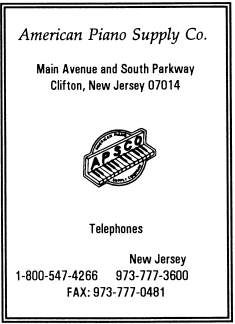|
by Paul Eccardt, Chapter President String tying has been done for years, but there are many tuners who still won't do it for what ever reason. To learn how to do it, just practice (but not in the customers home!). Use 13 gauge wire and do five a day at home, then go to a higher gauge wire for your practice. Once you've learned, you will wonder why you waited so long. You can use it on any string, but the bass section is the most beneficial, sometimes even on the hitch pin side of the string. There are several reasons why it is better to tie a string in the bass than to replace it. It sounds better than a universal string, more consistent with the rest of the bass section. Even if you replace both members of a bi-cord with two identical bass strings, the timbre of the note still wouldn't be the same as the notes next to it. The tuning holds a little better than it would on a new string. It looks better and more consistent with the rest of the bass strings. You don't have to make two service calls. You can make more money charging other customers for different types of service calls. Your customers will be happier. Here are some helpful tips for tying a string:
|
|

